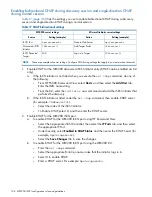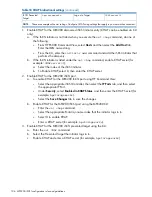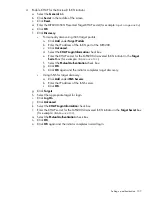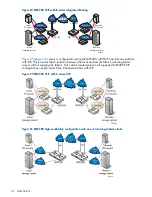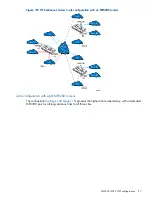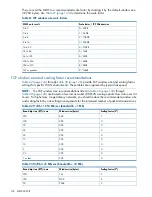
Figure 90 MPX200 high-availability configuration with fully-redundant long-distance links
Using FCIP to encapsulate FC packets
With FCIP, gateways transport FC frames over an IP network. From the perspective of the local
and remote fabrics, the FC devices accessed through the gateways appear to be part of one unified
fabric. This is possible because FC traffic is carried over the IP network in such a way that the FC
fabric and all FC devices on the fabric are unaware of the presence of the IP network. Once
configured, FCIP instances on each gateway become active and establish their connectivity through
the IP network. The FC devices in the local fabric access the FC devices in the remote fabric using
FC frames. The FC frames are encapsulated in IP packets by the local gateway and then transmitted
to the remote gateway. The remote gateway strips the IP packet data and passes only the FC frames
to the remote FC devices. The gateways deployed for FCIP are configured to use TCP, which uses
standard TCP flow control and error recovery algorithms.
FCIP Impact on existing iSCSI configurations
This guide includes samples of FCIP and iSCSI configurations to illustrate some of the many possible
configurations available. Despite the number of permutations, there are really only two basic FCIP
configurations: a dedicated FCIP blade and a shared iSCSI/FCIP blade.
A dedicated MPX200 blade running only FCIP does not have any impact on a dedicated MPX200
blade running iSCSI. There is, however, an impact and possibly changes required for existing
MPX200 iSCSI configurations when FCIP is added to the same blade. Also consider this possibility
when planning a new iSCSI/FCIP mixed blade configuration.
Configuring an FCIP route and specifying an FC and GE port pair take precedence over any
previous configuration for the port pair (FC/GE). This means that for an existing or new iSCSI
configuration, once an FCIP Route is configured, one FC port and one GE port are no longer
available for iSCSI or DM use.
For existing iSCSI configurations, there are two configuration cases to consider: one with a single
FC fabric (see
Figure 91 (page 110)
) connected to an MPX200 blade and one with dual FC fabrics
(see
Figure 92 (page 110)
) connected to an MPX200 blade. In the single FC fabric case (see
Figure 91 (page 110)
), the impact is minimal and can be resolved by rezoning any targets that
were zoned only with the FCIP FC port to the remaining iSCSI FC port of that blade. Once the
targets are rezoned, the impact to iSCSI is the loss of one 1 GbE port.
Using FCIP to encapsulate FC packets 109










